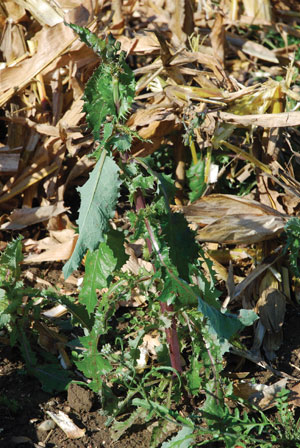
Features
Agronomy
Other Crops
Identification of weeds goes high-tech
Learning what weeds are invading fields is much easier with online tools.
February 21, 2009 By Treena Hein
Weed identification skills are something that can, and should, be constantly improved. Efficient identification of weeds, especially young weeds, helps growers choose the right herbicide sooner and achieve better overall weed control.
To help farmers do just that, a team of experts has created several online tools available at www.ontarioweeds.com. Headed by Mike Cowbrough, weed management field crop program lead with the Ontario Ministry of Agriculture, Food and Rural Affairs, the team includes other OMAFRA specialists, as well as experts from Agriculture and Agri-Food Canada, Wilfrid Laurier University and the University of Guelph.

|
| For growers, using the weed identification tool is as easy as e-mailing a digital photo. |
Visitors to the site are first presented with the “Search” function. “This allows producers to input some key words that will help them narrow down the weed they are trying to identify,” says Cowbrough. “Key words might be related to aspects such as the colour of flower, smell of the weed, or the shape of the stem. The more key words you input, the narrower the given results will be.” Once the search results are presented, users can click on the weed species for more information, such as photos and diagrams.
Those who are a little more certain of what they have can go straight to the “Weed Index” option, which presents an alphabetical list of weeds, but the list can be narrowed according to whether a
grower would like to see grasses and/or broadleaf weeds listed, perennial or non-perennial or noxious/not-noxious. “The glossary helps users learn the official terms for parts of the weed, its plant morphology,” says Cowbrough.
If growers are really stumped, they can click on “Weed ID Services” and send in pictures. The site experts will respond to a query as quickly as they can. “There are certain things that are most helpful to us in terms of pictures,” says Cowbrough. We explain on this page of the site that in all or most of your pictures, you should include a reference object (for example, a coin) so that the approximate size of the plant part can be identified. Also, along with a whole plant picture, take pictures of every distinguishable feature of the plant (e.g., leaf, stem, flower, etc.). It is always better to have too many photographs versus not enough.”
Cowbrough adds that the vast majority of the few weeds that have not been identified by sent-in pictures have been due to several reasons, including poor quality photos and/or no reference object provided to show the size of the object in the picture. Sometimes, Cowbrough adds, “No additional information is provided, like leaf orientation and other morphological clues, or the information is contradictory to what the photo shows, thus adding confusion.”
However, before photos are sent in, Cowbrough suggests users try the “Search” and also click on “Weed Identifier” on the top right of the “Weed ID Services” page, to see pictures of weeds sent in by stumped farmers. “Over 80 species have been identified,” he says, “and you may find the one you are looking at.”